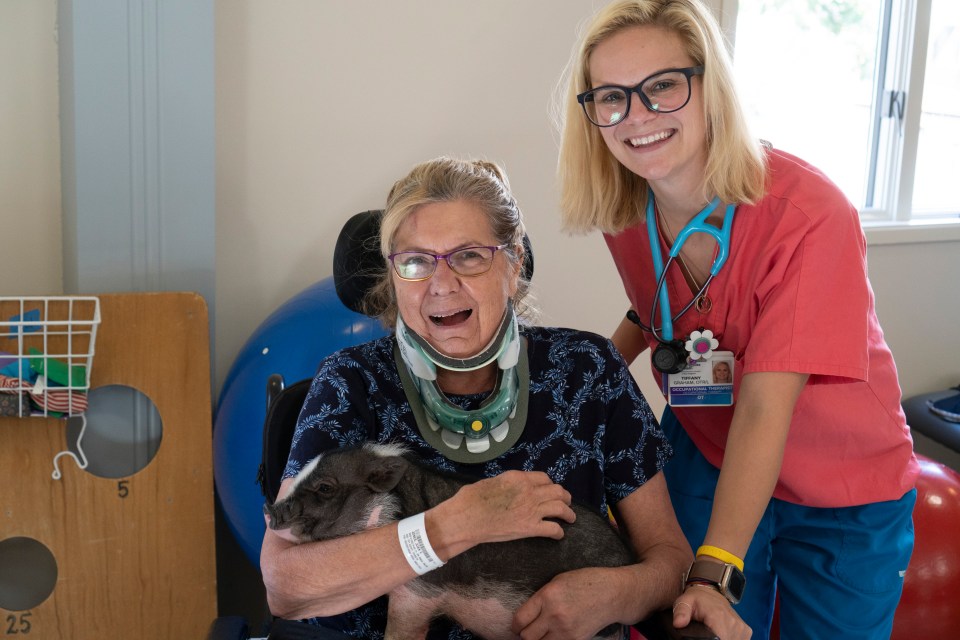What’s all the to-do with animal therapy these days? Sure, animals can be cute, soft and good company. They’re nonjudgmental and give love just because they’re wired that way. Some sense when you’re down, offering support when you need it. Others encourage activity, giving you reason to care. So, what’s all the buzz? Simple. Animal therapy is here because it makes a difference in healing, and that’s a good thing to keep around.
Today, animal therapy plays an important role in many settings including schools, mental health programs, veteran programs and rehabilitation hospitals. Animal-assisted therapy is a more structured, goal-directed intervention, where a trained, certified animal is introduced as an integral part of an individual’s treatment strategy to meet goals of independence.Therapeutic visitation animals begin as household pets and later train to bring comfort and joy to people living away from home due to physical or mental illness. Some nursing homes or assisted living facilities provide and care for their own facility therapy animals, which assist residents with Alzheimer’s, dementia and other related conditions.
Known for their keen sensitivity to human emotion, dogs are the most common therapy animal. Many breeds have the special capacity to empathize, offering sympathy through gentle interactions when detecting emotional sadness. Horses also share this intuition to provide therapeutic benefits, especially to individuals with autism and developmental delays. And cats have proven to be excellent companions, demonstrating their own unique style of healing through a lucid, calming presence. Other animals taking part in programs include guinea pigs, birds, baby goats and, believe it or not, chickens.
Animal therapy is not only good for the person being treated, it’s also useful for healthcare teams that work with patients every day. Take a look at the following ways animal therapy benefits patients and medical professionals.
Jumpstarts Performance
Add animal-assisted therapy to a person’s day and you’re likely to see a difference right away. That’s because animal therapy releases a phenylethylamine, a natural brain stimulant that improves mental and physical energy, while decreasing brain-fog to motivate patients to join in activities and work harder. Brushing a dog’s fur, throwing a ball for retrieval or walking alongside a dog improves motor skills and joint movement in patients. Therapy teams benefit as well, meeting their goals for more productive sessions and smiles all around.
All-Natural Pain Relief
Pain can greatly deter progress in rehabilitation therapy. Having animal therapy in the program can cause a release of endorphins for patients, counteracting the body’s reaction to pain with a sense of pleasure. As a result, patient therapy is more successful and the need for pain medication may lessen, diminishing potential side effects that hinder progress.
Stress and Anxiety Reducer
The simple presence of a therapy animal takes a person’s mind off his or her worries, lowering stress levels for better recovery. This allows the patient to breathe slower to relax, enjoying a welcomed distraction from fear and obstacles. These benefits trickle down to cardiovascular health, too, even for patients with advanced heart failure.
Elevates Mood
Being around animals can lead to an emotional connectedness, one that gives a sense of overall contentment. That’s partially because, when socializing with pets, the brain releases endorphins to ease loneliness, while adding a sense of purpose. The National Institute of Mental Health has noted animal therapy as a type of psychotherapy for treating depression and other mood disorders, which can often accompany health conditions. Happier patients lead to greater progress, helping medical teams do their job more successfully.
Calms Agitation
There are many cognitive conditions that can cause agitation, a shaken set of emotions. These include stroke, brain injury and dementia. A recent trial found that animal-assisted therapy lessened problematic behaviors in people with dementia. Participants fed, petted and groomed the animal, while interacting with its trainer. At the end of the study, participants achieved an average of 25% higher scores on the CMAI scale, which rates agitation levels. Having emotions under control keeps patients and medical teams on track to make headway on goals.
Lowers Blood Pressure and Heart Rate
If you’re a pet owner, you may have noticed your heart rate slow when spending quiet time together. It works for blood pressure, too. Animal-assisted therapy with horses has been shown to do both, while alleviating stress and reducing symptoms of anxiety and depression. Another six-week study, where participants spent periods of time holding and petting a cat, showed significant improvement in systolic and diastolic blood pressure. Lowering blood pressure can benefit overall health, lessening risk for stroke or heart attack.
Opens Up Communication
Have you ever noticed how doing a fun activity with family or friends opens the door for easier conversation? Same goes for animal therapy, which can help patients and medical teams get more comfortable with each other, forming a relationship that encourages teamwork and positivity.
If you or a loved one is spending time in recovery, rehabilitation or a long-term care facility, ask whether animal therapy is available and experience the benefits first-hand.
References
https://www.healthline.com/health/pet-therapy#candidates
https://www.therapydogs.com/animal-therapy-dogs/
5. Baun M. M., McCabe B. W. Companion animals and persons with dementia of the Alzheimer’s type: therapeutic possibilities. American Behavioral Scientist. 2003;47(1):42–51. doi: 10.1177/0002764203255211. [CrossRef] [Google Scholar]
Effects of animal-assisted therapy on agitated behaviors and social interactions of older adults with dementia. The American Journal of Alzheimer’s Disease and other Dementias. 2003;18(6):353–358. doi: 10.1177/153331750301800610. [PubMed] [CrossRef] [Google Scholar]
M. Cole, Kathie, RN, MN, CCRN, Gawlinksi, Anna, RN, DNSc, Kotlerman, Jenny, MS, and Steers, Neil, Ph.D. American Journal of Critical Care Animal-Assisted Therapy in Patients Hospitalized With Heart Failure
The content of this site is for informational purposes only and should not be taken as professional medical advice. Always seek the advice of your physician or other qualified healthcare provider with any questions you may have regarding any medical conditions or treatments.



